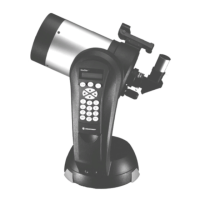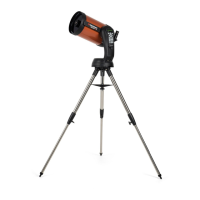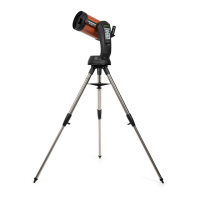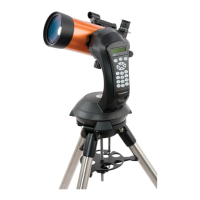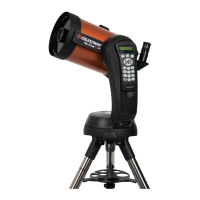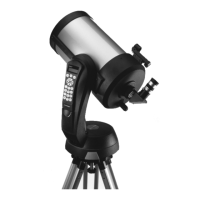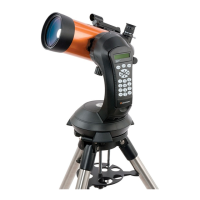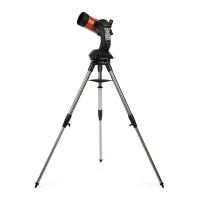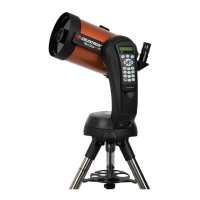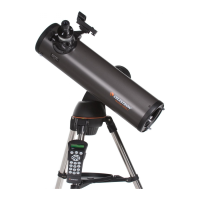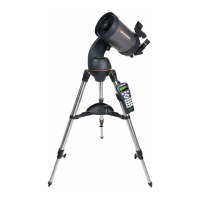Do you have a question about the Celestron NexStar 5 SE and is the answer not in the manual?
Guide to putting together the telescope components.
Instructions on how to supply power to the telescope.
Details about the telescope's primary interface.
Steps for aligning the telescope with the sky.
Techniques to enhance telescope precision.
Accessing and selecting celestial objects from the database.
Moving the telescope to celestial targets.
Automatic tours of interesting sky objects.
Customizing telescope operational parameters.
Accessing advanced telescope functions.
Adjusting focus and calculating telescope power.
Tips for optimal viewing experience.
Tips for viewing the Moon.
Guide to observing planets.
Safe procedures for observing the Sun.
Techniques for viewing distant objects.
Factors affecting image clarity and detail.
Proper methods for cleaning telescope lenses.
Adjusting optical alignment for optimal performance.
Magnification enhancers and viewing lenses.
Enhancing views and preserving night vision.
Detailed specifications of the telescope.
Definitions of key astronomical and technical terms.
Connecting telescope to a computer via RS-232.
Visual reference for global time zones.
Star chart for January and February.
Star chart for March and April.
Star chart for May and June.
Star chart for July and August.
Star chart for September and October.
Star chart for November and December.
Guide to putting together the telescope components.
Instructions on how to supply power to the telescope.
Details about the telescope's primary interface.
Steps for aligning the telescope with the sky.
Techniques to enhance telescope precision.
Accessing and selecting celestial objects from the database.
Moving the telescope to celestial targets.
Automatic tours of interesting sky objects.
Customizing telescope operational parameters.
Accessing advanced telescope functions.
Adjusting focus and calculating telescope power.
Tips for optimal viewing experience.
Tips for viewing the Moon.
Guide to observing planets.
Safe procedures for observing the Sun.
Techniques for viewing distant objects.
Factors affecting image clarity and detail.
Proper methods for cleaning telescope lenses.
Adjusting optical alignment for optimal performance.
Magnification enhancers and viewing lenses.
Enhancing views and preserving night vision.
Detailed specifications of the telescope.
Definitions of key astronomical and technical terms.
Connecting telescope to a computer via RS-232.
Visual reference for global time zones.
Star chart for January and February.
Star chart for March and April.
Star chart for May and June.
Star chart for July and August.
Star chart for September and October.
Star chart for November and December.
| Aperture | 125 mm (4.92 in) |
|---|---|
| Focal Length | 1250 mm (49 in) |
| Focal Ratio | f/10 |
| Mount Type | Single Fork Arm Altazimuth |
| Optical Design | Schmidt-Cassegrain |
| Highest Useful Magnification | 295x |
| Lowest Useful Magnification | 18x |
| Limiting Stellar Magnitude | 13 |
| Resolution (Rayleigh) | 1.11 arc seconds |
| Resolution (Dawes) | 0.93 arc seconds |
| Finderscope | StarPointer finderscope |
| Optical Coatings | StarBright XLT |
| Slew Speeds | 9 slew speeds |
| Database | 40, 000+ objects |
| Light Gathering Power | 329x |
| Eyepiece | 25 mm (50x) |
| Star Diagonal | 1.25-inch |
| Tripod | Steel |
| Power Supply | 8 x AA batteries or AC adapter |
| Tracking Rates | Sidereal, Solar, Lunar |
| Tracking Modes | Alt-Az |
| Communication Ports | RS-232 |
| GPS | Optional |
| Height | 48.26 cm (19 inches) |
| Width | 40.64 cm (16 inches) |
| Length | 50.8 cm (20 inches) |
